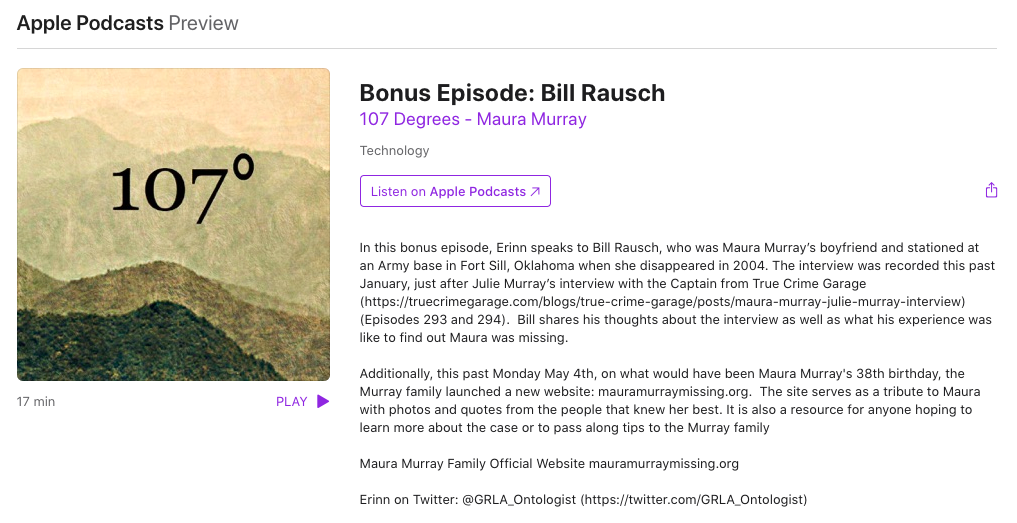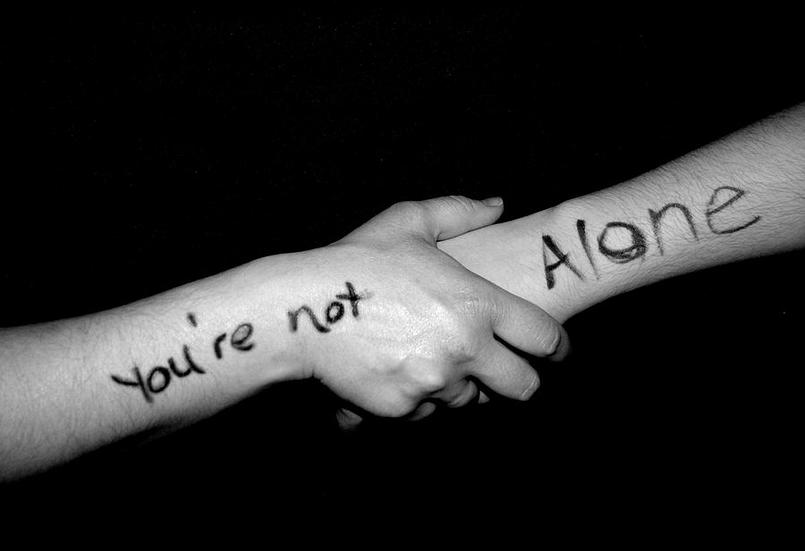|
In recognition of Maura Murray’s 38th bday on May 4, 2020, I spoke briefly with Erinn Larkin, co-host of 107 Degrees Maura Murray podcast (click on image below) and shared my thoughts on Julie Murray’s interview with "The Captain" from True Crime Garage, some of my favorite memories of Maura, and how I found out she disappeared.
For those who don't know, I was Maura’s boyfriend when she disappeared in 2004. I’d like to thank those interested in Maura’s case, the folks who raise awareness of who Maura really was, and the volunteers who help the Murray family each and everyday to find her and bring her home. Maura’s family launched a new website on her birthday, a tribute to Maura and a resource for those interested in the case. Please visit the website at www.mauramurraymissing.org, sign-up, and together we will #FindMaura! Listen here or click on the image below to be taken to the 107 Degrees Maura Murray podcast.
0 Comments
March Madness is upon us! As we widdle our way from the sweet sixteen to the elite eight, I am traveling back to Columbus, Ohio to be recognized by the Ohio High School Athletic Association (OHSAA) as a member of the 1998 Div. III High School State Championship team, the Highland Fighting Scots.
It’s been twenty years since we defeated Cincinnati Indian Hill 80-61 to cap off our historic 27-1 season. I’ll never forget cutting down the nets in St. John arena, where The Ohio State Basketball team once played, capturing the first state championship for our small town High School. Over the years, I’ve come to love March Madness not simply because I grew up playing basketball, or because of the entertainment and excitement it creates; but because March Madness is a series of life lessons played out before a national audience that apply to everyone from the players on the court to the fans watching at home. As we inch closer to the Final Four, here are my eight elite life lesson from March Madness:

Most Americans who haven’t worn a uniform or had a loved one who served think about veterans maybe once or twice a year — during national holidays or when they happen see a yellow ribbon sticker on the bumper of a car. What they don’t know is that veterans are all around them: leading PTA meetings, serving as elected officials and volunteering at the local community center. In fact, veterans are America’s greatest — if sometimes overlooked — civic asset.
There are many ways veterans are going above and beyond the call of duty when it comes to volunteering, voting and other key areas of civic engagement in our country. Learn more here. Ten years ago, September 2007, I came home to the U.S. after finishing a long combat tour in Baghdad, Iraq. During the months I was in Iraq from 2006 to 2007, the United States lost 1,491 military members, roughly ⅓ of the total deaths in Iraq from 2003-2017. I went to many vigils and memorial services; some for soldiers I knew, some for soldiers I didn’t. I was fortunate and came home uninjured and transitioned out of the active army back into the civilian work force.
While I often think about my friends and military members who didn’t come home, there is one death that took place while I was over there that I think about everyday, my oldest sister Heather. It was April 20, 2007 and my roommate and I were asleep. The chief of my task force woke us both up knocking on the door and when I answered I could tell by the look on his face that something was wrong. He told me something had happened back home as he handed me an Iraqna cell phone. My father spoke with me on the phone with a tone of voice I’d never heard before. He preceded to tell me that my oldest sister died by suicide. From 1999 to 2014 the suicide rate in the United States increased 24%, from 10.5 to 13.0 suicides per 100,000 people, the highest rate recorded in 28 years. Currently, suicide is the 10th leading cause of death in the United States. In 2015, suicide was the second leading cause of death for young people ages 15 to 24 and the third leading cause of death for those between the ages of 10 and 14. Approximately half of all suicides are committed by firearms, which accounts for roughly two-thirds of all firearms deaths. Together, these facts tell a story that most Americans are unaware of; our country has a deadly problem, suicide. In my current role as the Executive Director of Got Your 6 (military slang for “I’ve got your back!”), a national campaign focused on veteran empowerment, I’ve been able to join forces with like minded organizations and people to speak out against stigma about mental health and begin to change the conversation. We’ve seen progress gaining national attention on suicide among veterans, but as more and more America’s learn that 20 veterans die by suicide everyday, I can’t help but worry that the public is unaware that suicide is an American problem, not just a veteran problem. On February 12, 2015 I sat in the East Room of the White House as President Obama signed The Clay Hunt Suicide Prevention for American Veterans (SAV) Act into law. The law required independent reviews of the VA and the Department of Defense programs aimed at preventing suicide, created peer support and community outreach pilot programs, and formed a program to repay loan debt for psychiatry students to incentivize them to work in the VA health system. While the law has been successful, additional funding did not accompany the bill making it difficult to fully implement. In a September Senate Veterans Affairs Committee (SVAC) hearing, lawmakers and VA Secretary Shulkin admitted that despite the loan repayment program and other incentives, the VA has not yet hired the 1,000 mental health professionals needed across the VA network. This failure points to a larger problem in the United States, highlighted by many Senators during the hearing; the United States has a nationwide shortage of mental health providers. According to analysis by the U.S. Health Resources & Services Administration, the nation needs to add 10,000 providers to each of seven separate mental health care professions by 2025 to meet the expected growth in demand. While the VA has failed to bring 1,000 mental healthcare professionals into the largest healthcare network in the country, our nation needs to add nearly 10,000 new professionals a year between now and 2025 to meet demand. I’m no doctor but the prognosis is clear; our nation is in critical condition and if we do not have a national strategy to recruit, train and retain mental health professionals while raising awareness of mental health issues among the general public, suicide rates will continue to grow and it will become more and more difficult to address this crisis. Without a national strategy, addressing suicide within subsets of the population will have limited impact. While I didn’t know that September was suicide prevention month when I came home from Iraq in 2007, I now know that we must focus on suicide prevention every day of every month. I also know the power of sharing our stories and being informed on the issues that impact our families and communities. If you know someone who died by suicide, share their story. Share your story. Know the signs. Be there for each other. Together we can help America realize that we have a problem. Until then we will not be able to address it fully.  I was raised to stand during the national anthem, take my hat off and place my hand over my heart. Growing up I always had goosebumps while the band played the national anthem thinking of those who paid the ultimate sacrifice. Later after becoming a soldier I thought more about friends who didn't make it home and still others who are deployed across the globe doing their job to keep us safe. I'll teach my son and daughter to do as I was raised because of what I believe in. As the world becomes an ever increasingly divided place, our country, our flag, our anthem and our values can and should be what unites us. At some point I expect my children to ask me why they have to stand while other kids don't. It's a question I asked my father when I was a kid. I'll tell them that everyone should stand and respect our flag and our national anthem, but because we live in America no one has to. They have the right to talk during the anthem, order a hot dog, or kneel in protest if they choose. We don't have to like it but we should try to understand their perspective as we would expect them to understand ours. While I wish everyone would stand during our anthem, I also wish that everyone was treated equal in our great nation regardless of race, religion, gender, or sexual orientation. Sadly, as great as our nation is, we still have work to do. Ultimately, we should celebrate our diversity because it is what makes us great and what brings us together. That includes the right people have to kneel in protest during the national anthem. To be clear, I will always stand during the anthem and believe others should do the same. Perhaps those kneeling in protest have a similar perspective of their actions during the anthem, I don't know. While I try to understand their perspective and actions, I would ask them to try and understand mine. At the end of the day we needn’t hate or talk down to one another. We can even be friends. A man I know and respect often says "we are the land of the free because of the brave." In my mind, that is why I will always stand. At the same time, I'll change one word (replace 'say' with 'do') from a famous quote by Evelyn Beatrice Hall and say to those who decide to kneel, "I disapprove of what you do, but I will defend to the death your right to do it." Regardless of whether you stand or kneel, let us resolve ourselves to be united as a people who believe in life, liberty and the pursuit of happiness. Let us reject hate and divisiveness while treating others how they would like to be treated. All of us can and should lead by example allowing our actions to speak louder than words. Some will stand, some will kneel and we will all be Americans. |
Bill RauschCitizen. Soldier. Volunteer. Archives
May 2020
Categories |




 RSS Feed
RSS Feed
